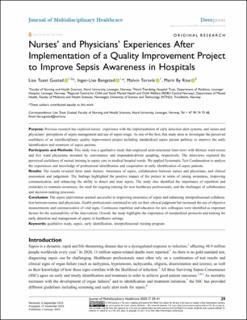| dc.contributor.author | Gustad, Lise Tuset | |
| dc.contributor.author | Bangstad, Inger-Lise | |
| dc.contributor.author | Torsvik, Malvin Arnold | |
| dc.contributor.author | Rise, Marit By | |
| dc.date.accessioned | 2024-01-23T10:12:27Z | |
| dc.date.available | 2024-01-23T10:12:27Z | |
| dc.date.created | 2024-01-19T14:50:55Z | |
| dc.date.issued | 2024 | |
| dc.identifier.issn | 1178-2390 | |
| dc.identifier.uri | https://hdl.handle.net/11250/3113288 | |
| dc.description.abstract | Purpose: Previous research has explored nurses´ experience with the implementation of early detection alert systems, and nurses and physicians’ perceptions of sepsis management and use of sepsis triage. As one of the first, this study aims to investigate the perceived usefulness of an interdisciplinary quality improvement project including standardized sepsis patient pathway to improve the early identification and treatment of sepsis patients.
Participants and Methods: This study was a qualitative study that employed semi-structured interviews with thirteen ward nurses and five ward physicians recruited by convenience and respondent-driven sampling, respectively. The interviews explored the perceived usefulness of mutual training in sepsis care in medical hospital wards. We applied Systematic Text Condensation to analyze the experiences and knowledge of professional identification and cooperation in early identification of sepsis patients.
Results: The results revealed three main themes: Awareness of sepsis, collaboration between nurses and physicians, and clinical assessment and judgement. The findings highlighted the positive impact of the project in terms of raising awareness, improving communication, and enhancing the ability to detect and treat sepsis. The study also identified the importance of repetition and reminders to maintain awareness, the need for ongoing training for new healthcare professionals, and the challenges of collaboration and decision-making processes.
Conclusion: The sepsis intervention seemed successful in improving awareness of sepsis and enhancing interprofessional collaboration between nurses and physicians. Health professionals continued to rely on their clinical judgment but increased the use of objective measurements and communication of vital signs. Continuous repetition and education for new colleagues were identified as important factors for the sustainability of the intervention. Overall, the study highlights the importance of standardized protocols and training for early detection and management of sepsis in healthcare settings. | en_US |
| dc.language.iso | eng | en_US |
| dc.publisher | Dovepress | en_US |
| dc.rights | Navngivelse-Ikkekommersiell 4.0 Internasjonal | * |
| dc.rights.uri | http://creativecommons.org/licenses/by-nc/4.0/deed.no | * |
| dc.title | Nurses' and Physicians' Experiences After Implementation of a Quality Improvement Project to Improve Sepsis Awareness in Hospitals | en_US |
| dc.title.alternative | Nurses' and Physicians' Experiences After Implementation of a Quality Improvement Project to Improve Sepsis Awareness in Hospitals | en_US |
| dc.type | Peer reviewed | en_US |
| dc.type | Journal article | en_US |
| dc.description.version | publishedVersion | en_US |
| dc.source.pagenumber | 29-41 | en_US |
| dc.source.volume | 17 | en_US |
| dc.source.journal | Journal of Multidisciplinary Healthcare | en_US |
| dc.identifier.doi | 10.2147/JMDH.S439017 | |
| dc.identifier.cristin | 2230651 | |
| cristin.ispublished | true | |
| cristin.fulltext | original | |
| cristin.qualitycode | 1 | |

